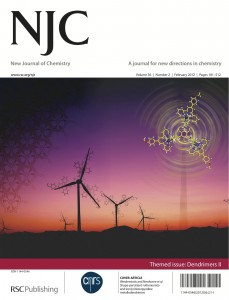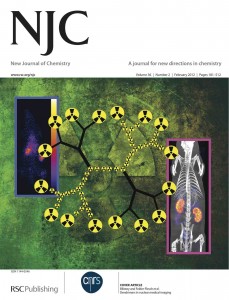This month sees the following articles in New Journal of Chemistry that are in the top ten most accessed:-
A Ag+-selective ?off?on? probe based on a naphthalimide derivative
Jun Zhang , Chunwei Yu , Gang Lu , Qiongyao Fu , Na Li and Yuxiang Ji
New J. Chem., 2012, 36, 819-822 DOI: 10.1039/C2NJ20974H
Thiophene-substituted aza-bodipy as a strategic synthon for the design of near-infrared dyes
Quentin Bellier , Fabrice Dalier , Erwann Jeanneau , Olivier Maury and Chantal Andraud
New J. Chem., 2012, 36, 768-773 DOI: 10.1039/C2NJ20943H
PEG-dendritic block copolymers for biomedical applications
Ana Sousa-Herves , Ricardo Riguera and Eduardo Fernandez-Megia
New J. Chem., 2012, 36, 205-210 DOI: 10.1039/C2NJ20849K
Au(i)- and Pt(ii)-N-heterocyclic carbene complexes with picoline functionalized benzimidazolin-2-ylidene ligands; synthesis, structures, electrochemistry and cytotoxicity studies
Sirsendu Das Adhikary , Dipayan Bose , Partha Mitra , Krishna Das Saha , Valerio Bertolasi and Joydev Dinda
New J. Chem., 2012, 36, 759-767 DOI: 10.1039/C2NJ20928D
Shape-persistent, ruthenium(ii)- and iron(ii)-bisterpyridine metallodendrimers: synthesis, traveling-wave ion-mobility mass spectrometry, and photophysical properties
Jin-Liang Wang , Xiaopeng Li , Carol D. Shreiner , Xiaocun Lu , Charles N. Moorefield , Sreedhar R. Tummalapalli , Douglas A. Medvetz , Matthew J. Panzner , Frank R. Fronczek , Chrys Wesdemiotis and George R. Newkome
New J. Chem., 2012, 36, 484-491 DOI: 10.1039/C2NJ20799K
Ln(iii)-cored complexes based on boron dipyrromethene (Bodipy) ligands for NIR emission
Jung Ho Ryu , Yu Kyung Eom , Jean-Claude G. Bünzli and Hwan Kyu Kim
New J. Chem., 2012, 36, 723-731 DOI: 10.1039/C2NJ20786A
One-pot hydrothermal synthesis of graphene quantum dots surface-passivated by polyethylene glycol and their photoelectric conversion under near-infrared light
Jianhua Shen , Yihua Zhu , Xiaoling Yang , Jie Zong , Jianmei Zhang and Chunzhong Li
New J. Chem., 2012, 36, 97-101 DOI: 10.1039/C1NJ20658C
Stimuli sensitive amphiphilic dendrimers
Rajasekhar R. Ramireddy , Krishna R. Raghupathi , Diego Amado Torres and S. Thayumanavan
New J. Chem., 2012, 36, 340-349 DOI: 10.1039/C2NJ20879B
MOFs, MILs and more: concepts, properties and applications for porous coordination networks (PCNs)
Christoph Janiak and Jana K. Vieth
New J. Chem., 2010, 34, 2366-2388 DOI: 10.1039/C0NJ00275E
Glycodendrimers as functional antigens and antitumor vaccines
Tze Chieh Shiao and René Roy
New J. Chem., 2012, 36, 324-339 DOI: 10.1039/C2NJ20873C
Why not take a look at the articles today and blog your thoughts and comments below.
Fancy submitting an article to New Journal of Chemistry? Then why not submit to us today or alternatively email us your suggestions.


















